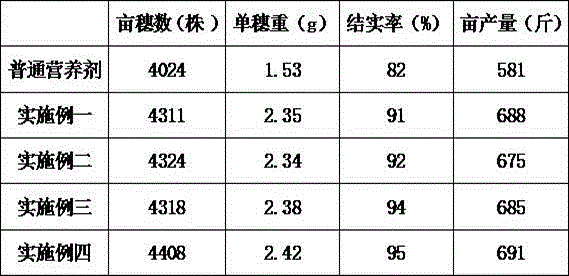Novel wheat field composite bactericide and use thereof
A compound fungicide and wheat technology, applied in the direction of fungicide, application, biocide, etc., can solve the problems of sterilizing wheat damage, affecting production, etc., to achieve the effect of improving bactericidal effect, promoting growth, and broad spectrum of insecticide
- Summary
- Abstract
- Description
- Claims
- Application Information
AI Technical Summary
Problems solved by technology
Method used
Image
Examples
Embodiment 1
[0016] The proportion of ingredients used is: 20 parts of Artemisia annua plant extract, 2 parts of spreading agent, 5 parts of naphthalene acetic acid, 8 parts of brassinolide, 7 parts of beta-permethrin, 10 parts of surfactant, penetration enhancer 8 parts of ketone, 5 parts of glycine, 10 parts of dichloromethane, 5 parts of geranium, 10 parts of drunk horse grass, 5 parts of eucalyptus, 1 part of veratrine, 5 parts of humic acid and 10 parts of polar organic solvent share.
[0017] In this embodiment, the surfactant is a mixture of Tween 20 and alkylaryl polyoxyethylene ether.
[0018] In this embodiment, the polar organic solvent is a mixture of isopropanol, ethylene glycol monoethyl ether and dimethylisosorbide.
[0019] The preparation method of the present embodiment comprises the following steps:
[0020] A. Put geranium, drunken horse grass, and eucalyptol into a pulverizer to pulverize and stir, and then filter the residue to obtain the A mixture;
[0021] B. Pou...
Embodiment 2
[0025] The proportion of ingredients used is: 22 parts of Artemisia annua plant extract, 3 parts of spreading agent, 6 parts of naphthalene acetic acid, 9 parts of brassinolide, 8 parts of beta-permethrin, 12 parts of surfactant, penetration enhancer 9 parts of ketone, 6 parts of glycine, 12 parts of dichloromethane, 6 parts of geranium, 12 parts of drunk horse grass, 6 parts of eucalyptus, 2 parts of veratrine, 6 parts of humic acid and 12 parts of polar organic solvent share.
[0026] In this embodiment, the surfactant is a mixture of Tween 20 and alkylaryl polyoxyethylene ether.
[0027] In this embodiment, the polar organic solvent is a mixture of isopropanol, ethylene glycol monoethyl ether and dimethylisosorbide.
[0028] The preparation method of the present embodiment comprises the following steps:
[0029] A. Put geranium, drunken horse grass, and eucalyptol into a pulverizer to pulverize and stir, and then filter the residue to obtain the A mixture;
[0030] B. Po...
Embodiment 3
[0034] The proportion of ingredients used is: 40 parts of Artemisia annua plant extract, 6 parts of spreading agent, 12 parts of naphthalene acetic acid, 12 parts of brassinolide, 14 parts of beta-permethrin, 20 parts of surfactant, penetration enhancer 16 parts of ketone, 10 parts of glycine, 20 parts of dichloromethane, 8 parts of geranium, 20 parts of drunk horse grass, 10 parts of eucalyptol, 4 parts of veratrine, 10 parts of humic acid and 20 parts of polar organic solvent share.
[0035] In this embodiment, the surfactant is a mixture of Tween 20 and alkylaryl polyoxyethylene ether.
[0036] In this embodiment, the polar organic solvent is a mixture of isopropanol, ethylene glycol monoethyl ether and dimethylisosorbide.
[0037] The preparation method of the present embodiment comprises the following steps:
[0038] A. Put geranium, drunken horse grass, and eucalyptol into a pulverizer to pulverize and stir, and then filter the residue to obtain the A mixture;
[0039...
PUM
 Login to View More
Login to View More Abstract
Description
Claims
Application Information
 Login to View More
Login to View More - R&D
- Intellectual Property
- Life Sciences
- Materials
- Tech Scout
- Unparalleled Data Quality
- Higher Quality Content
- 60% Fewer Hallucinations
Browse by: Latest US Patents, China's latest patents, Technical Efficacy Thesaurus, Application Domain, Technology Topic, Popular Technical Reports.
© 2025 PatSnap. All rights reserved.Legal|Privacy policy|Modern Slavery Act Transparency Statement|Sitemap|About US| Contact US: help@patsnap.com


